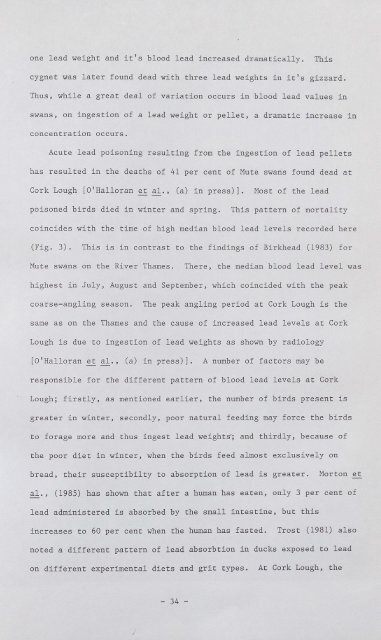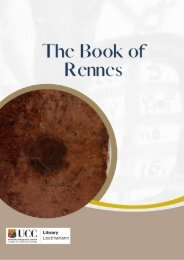Lead Toxicity in Mute Swans
LEAD TOXICITY IN MUTE SWANS Cygnus olor (Gmelin). By JOHN O'HALLORAN A thesis submitted to the National University of Ireland in candidature for the degree of Doctor of Philosophy September 1987
LEAD TOXICITY IN MUTE SWANS
Cygnus olor (Gmelin).
By
JOHN O'HALLORAN
A thesis submitted to the National University of Ireland
in candidature for the degree of Doctor of Philosophy
September 1987
You also want an ePaper? Increase the reach of your titles
YUMPU automatically turns print PDFs into web optimized ePapers that Google loves.
one lead weight and it's blood lead <strong>in</strong>creased dramatically.<br />
This<br />
cygnet was later found dead with three lead weights <strong>in</strong> it's gizzard.<br />
Thus, while a great deal of variation occurs <strong>in</strong> blood lead values <strong>in</strong><br />
swans, on <strong>in</strong>gestion of a lead weight or pellet, a dramatic <strong>in</strong>crease <strong>in</strong><br />
concentration occurs.<br />
Acute lead poison<strong>in</strong>g result<strong>in</strong>g from the <strong>in</strong>gestion of lead pellets<br />
has resulted <strong>in</strong> the deaths of 41 per cent of <strong>Mute</strong> swans found dead at<br />
Cork Lough [O'Halloran et al., (a) <strong>in</strong> press)]. Most of the lead<br />
poisoned birds died <strong>in</strong> w<strong>in</strong>ter and spr<strong>in</strong>g.<br />
This pattern of mortality<br />
co<strong>in</strong>cides with the time of high median blood lead levels recorded here<br />
(Fig. 3).<br />
This is <strong>in</strong> contrast to the f<strong>in</strong>d<strong>in</strong>gs of Birkhead (1983) for<br />
<strong>Mute</strong> swans on the River Thames.<br />
There, the median blood lead level was<br />
highest <strong>in</strong> July, August and September, which co<strong>in</strong>cided with the peak<br />
coarse-angl<strong>in</strong>g season.<br />
The peak angl<strong>in</strong>g period at Cork Lough is the<br />
same as on the Thames and the cause of <strong>in</strong>creased lead levels at Cork<br />
Lough is due to <strong>in</strong>gestion of lead weights as shown by radiology<br />
[O'Halloran et al., (a) <strong>in</strong> press)]. A number of factors may be<br />
responsible for the different pattern of blood lead levels at Cork<br />
Lough; firstly, as mentioned earlier, the number of birds present is<br />
greater <strong>in</strong> w<strong>in</strong>ter, secondly, poor natural feed<strong>in</strong>g may force the birds<br />
to forage more and thus <strong>in</strong>gest lead weights·; and thirdly, because of<br />
the poor diet <strong>in</strong> w<strong>in</strong>ter, when the birds feed almost exclusively on<br />
bread, their susceptibilty to absorption of lead is greater. Morton et<br />
al., (1985) has shown that after a human has eaten, only 3 per cent of<br />
lead adm<strong>in</strong>istered is absorbed by the small <strong>in</strong>test<strong>in</strong>e, but this<br />
<strong>in</strong>creases to 60 per cent when the human has fasted.<br />
Trost (1981) also<br />
noted a different pattern of lead absorbtion <strong>in</strong> ducks exposed to lead<br />
on different experimental diets and grit types.<br />
At Cork Lough, the<br />
- 34 -<br />
I
















